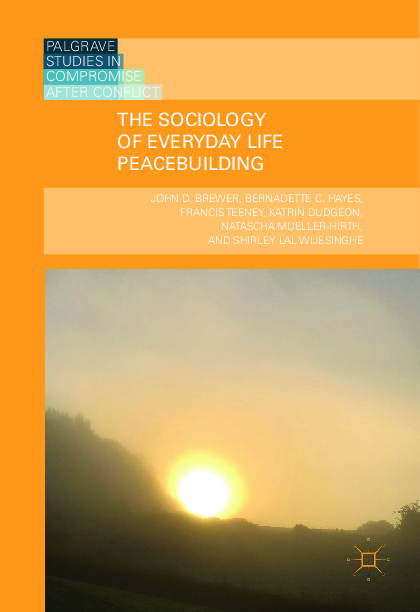File #2539: "2018_Book_TheSociologyOfEverydayLifePeac.pdf"
Text
1|Series Editor’s Preface|7
1|Acknowledgements|11
1|Contents|15
1|About the Authors|16
1|1: Introduction|19
2|Introduction|19
2|The Compromise After Conflict Research Programme|22
3|Victims and Compromise in Northern Ireland (2009–13)|24
3|Victims and Compromise in Sri Lanka (2011–14)|25
3|Compromise in South Africa (2010–13)|26
3|Victimhood, Truth Recovery and the Development of Compromise (2010–12)|26
2|Victim Centred Peacebuilding|27
2|Bibliography|28
1|2: Centring Victims in Peacebuilding|30
2|Introduction|30
2|What Is Everyday Life?|32
2|The Brutalization of Everyday Life|34
3|Victims and the Brutalization of Everyday Life|41
2|The Social Construction of Victimhood|43
3|The Additional Layers of Meaning to Victimhood|45
2|Victims as a Problem in Peace Processes|51
3|Victims as Burden on the Exchequer|52
3|Politicization of Victim Issues|52
3|Politicization by Victims|53
3|Canonization of ‘Preferred’ Victims|55
3|Lack of Agency and Autonomy of Victims|56
3|Lack of Voice by Victims|57
3|Cultural and Political Tropes of Victimhood|58
2|Centring Victims in Peacebuilding|61
2|Conclusion|62
2|Bibliography|66
1|3: Northern Ireland Voices|68
2|Introduction|68
2|The Northern Irish Conflict|69
2|The Northern Irish Sample of Victims|76
2|Who Are the Victims?|79
2|Victims’ Emotional Landscape|87
2|Coping and Stress|97
2|Dealing with the Past|100
2|Hope and Optimism for the Future|104
2|Conclusion|112
2|Bibliography|114
1|4: South African Voices|119
2|Introduction|119
2|The South African Conflict|120
2|Who Is the Victim?|132
2|Victims and Victim Identity|135
2|Victims’ Emotional Landscape|140
2|Hope and Optimism for a Better Future|150
2|A Shared Non-racial Future?|155
2|Dealing with the Past|159
2|Conclusion|165
2|Bibliography|167
1|5: Sri Lankan Voices|171
2|Introduction|171
2|The Sri Lankan Conflict|175
2|The Legacy of a Victor’s Peace|182
3|The Brutalisation of the Victor’s Peace and Its Implications for What Peace Means|187
2|Victims’ Emotional Landscape|194
2|Hopes for the Future|206
2|Conclusion|211
2|Bibliography|212
1|6: Everyday Life Peacebuilding|214
2|Introduction|214
2|What Is Everyday Life?|215
2|What Is Everyday Life Peacebuilding?|216
3|Roger Mac Ginty and Everyday Life Peacebuilding|219
2|Everyday Life Peacebuilding and the Problem of Dealing with the Past|222
2|The Problems with Everyday Life Peacebuilding|226
2|The Sociology of Everyday Mundane Reasoning by Victims|229
2|Mundane Reasoning and Everyday Life Peacebuilding|233
3|Reasserting Normal Routines as Peacebuilding|234
3|Tolerance, Civility and Compromise as Everyday Life Accomplishments|235
2|Everyday Life Peacebuilding or Ordinary Virtues?|250
2|Review of the Argument|252
2|Mainstreaming Victims in Peace Processes|253
3|The Reversal of Victim Mainstreaming in South Africa|254
2|Conclusion|263
2|Bibliography|266
1|7: Conclusion|270
2|Introduction|270
2|Absent-Present Victim Voices|271
2|Variations in the Case Countries|274
2|Temporal Tipping Points|278
2|The Sociology of Everyday Life Peacebuilding|280
3|The Importance of Everyday Life Peacebuilding|280
3|The Limitations of Everyday Life Peacebuilding|282
2|Conclusion|284
2|Bibliography|285
1|Bibliography|286
1|Index|310
1|Acknowledgements|11
1|Contents|15
1|About the Authors|16
1|1: Introduction|19
2|Introduction|19
2|The Compromise After Conflict Research Programme|22
3|Victims and Compromise in Northern Ireland (2009–13)|24
3|Victims and Compromise in Sri Lanka (2011–14)|25
3|Compromise in South Africa (2010–13)|26
3|Victimhood, Truth Recovery and the Development of Compromise (2010–12)|26
2|Victim Centred Peacebuilding|27
2|Bibliography|28
1|2: Centring Victims in Peacebuilding|30
2|Introduction|30
2|What Is Everyday Life?|32
2|The Brutalization of Everyday Life|34
3|Victims and the Brutalization of Everyday Life|41
2|The Social Construction of Victimhood|43
3|The Additional Layers of Meaning to Victimhood|45
2|Victims as a Problem in Peace Processes|51
3|Victims as Burden on the Exchequer|52
3|Politicization of Victim Issues|52
3|Politicization by Victims|53
3|Canonization of ‘Preferred’ Victims|55
3|Lack of Agency and Autonomy of Victims|56
3|Lack of Voice by Victims|57
3|Cultural and Political Tropes of Victimhood|58
2|Centring Victims in Peacebuilding|61
2|Conclusion|62
2|Bibliography|66
1|3: Northern Ireland Voices|68
2|Introduction|68
2|The Northern Irish Conflict|69
2|The Northern Irish Sample of Victims|76
2|Who Are the Victims?|79
2|Victims’ Emotional Landscape|87
2|Coping and Stress|97
2|Dealing with the Past|100
2|Hope and Optimism for the Future|104
2|Conclusion|112
2|Bibliography|114
1|4: South African Voices|119
2|Introduction|119
2|The South African Conflict|120
2|Who Is the Victim?|132
2|Victims and Victim Identity|135
2|Victims’ Emotional Landscape|140
2|Hope and Optimism for a Better Future|150
2|A Shared Non-racial Future?|155
2|Dealing with the Past|159
2|Conclusion|165
2|Bibliography|167
1|5: Sri Lankan Voices|171
2|Introduction|171
2|The Sri Lankan Conflict|175
2|The Legacy of a Victor’s Peace|182
3|The Brutalisation of the Victor’s Peace and Its Implications for What Peace Means|187
2|Victims’ Emotional Landscape|194
2|Hopes for the Future|206
2|Conclusion|211
2|Bibliography|212
1|6: Everyday Life Peacebuilding|214
2|Introduction|214
2|What Is Everyday Life?|215
2|What Is Everyday Life Peacebuilding?|216
3|Roger Mac Ginty and Everyday Life Peacebuilding|219
2|Everyday Life Peacebuilding and the Problem of Dealing with the Past|222
2|The Problems with Everyday Life Peacebuilding|226
2|The Sociology of Everyday Mundane Reasoning by Victims|229
2|Mundane Reasoning and Everyday Life Peacebuilding|233
3|Reasserting Normal Routines as Peacebuilding|234
3|Tolerance, Civility and Compromise as Everyday Life Accomplishments|235
2|Everyday Life Peacebuilding or Ordinary Virtues?|250
2|Review of the Argument|252
2|Mainstreaming Victims in Peace Processes|253
3|The Reversal of Victim Mainstreaming in South Africa|254
2|Conclusion|263
2|Bibliography|266
1|7: Conclusion|270
2|Introduction|270
2|Absent-Present Victim Voices|271
2|Variations in the Case Countries|274
2|Temporal Tipping Points|278
2|The Sociology of Everyday Life Peacebuilding|280
3|The Importance of Everyday Life Peacebuilding|280
3|The Limitations of Everyday Life Peacebuilding|282
2|Conclusion|284
2|Bibliography|285
1|Bibliography|286
1|Index|310

